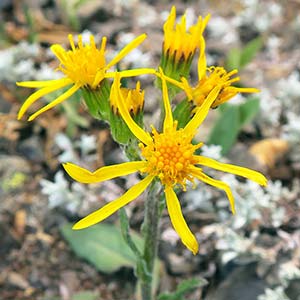Senecio lugens
Senecio jacobaea
black-tip groundsel, small blacktip ragwort
stinking willie, tansy ragwort
loosely, often unevenly, floccose-tomentose, glabrescent.
sparsely and unevenly tomentose, glabrescent except in leaf axils and among heads.
single or clustered.
(often purplish-tinged) usually single, sometimes loosely clustered.
reduced distally; petiolate;
blades narrowly obovate to oblanceolate, (4–)8–18(–25) cm, bases tapered, margins subentire to dentate (denticles callous; mid and distal leaves bractlike, clasping).
± evenly distributed (basal often withering before flowering); petiolate (sometimes obscurely);
blades ovate to broadly ovate (usually 1–3-pinnate, lobes mostly obovate to spatulate), (4–)7–20(–30) × (1–)2–5(–12) cm, bases usually tapered, ultimate margins dentate (distal leaves similar, smaller).
(± 5) ± 8 (± 13);
corolla laminae 8–10(–15) mm.
± 13;
corolla laminae 8–12 mm.
(± 8) ± 13 (± 21), 4–7 mm, tips black.
± 13, 3–4(–5) mm, tips black or greenish.
of 2–5 linear bractlets (1–2 mm).
of 2–6 (inconspicuous) bractlets (less than 2 mm).
(2–)7–12(–20+) in corymbiform arrays.
(10–)20–60+ in corymbiform arrays.
glabrous.
all sparsely hairy or ray cypselae glabrous.
= 40, 80.
= 40.
Senecio lugens
Senecio jacobaea
Senecio lugens varies greatly in robustness across its range. It is scattered widely in the Rocky Mountain uplift and adjacent regions from northern Wyoming to Alaska; it is disjunct in the Olympic Peninsula, Washington. Superficially similar to S. integerrimus, S. lugens has well-developed, coarse, spreading rootstocks with branching roots; S. integerrimus arises from foreshortened, buttonlike caudices with abundant unbranched, fleshy-fibrous roots.
(Discussion copyrighted by Flora of North America; reprinted with permission.)
Senecio jacobaea is a weed introduced from Europe and now well established in places of cool, damp summers. It is toxic to livestock and legally noxious in most states and provinces where it occurs.
The Russian botanist E. Wiebe (2000) resuscitated Jacobaea for plants that are treated here as Senecio jacobaea, S. erucifolius, and S. cannabifolius. Phylogenetic studies may confirm the utility of recognizing Jacobaea as a distinct genus; to do so here would be premature.
(Discussion copyrighted by Flora of North America; reprinted with permission.)
- Local floras:
BC,
CA,
OR,
WA
- Local Web sites:
CalFlora,
CalPhotos,
Flora NW,
Go Botany,
IL Wildflowers,
MI Flora,
PNW Herbaria,
Turner Photog.
WildflowerSearch
iNaturalist (observations)
USDA Plants Database
- LBJ Wildflower Center
- SEINet
- Plants of the World Online
- Encyclopedia of Life
- Wikipedia
- Google Image Search


